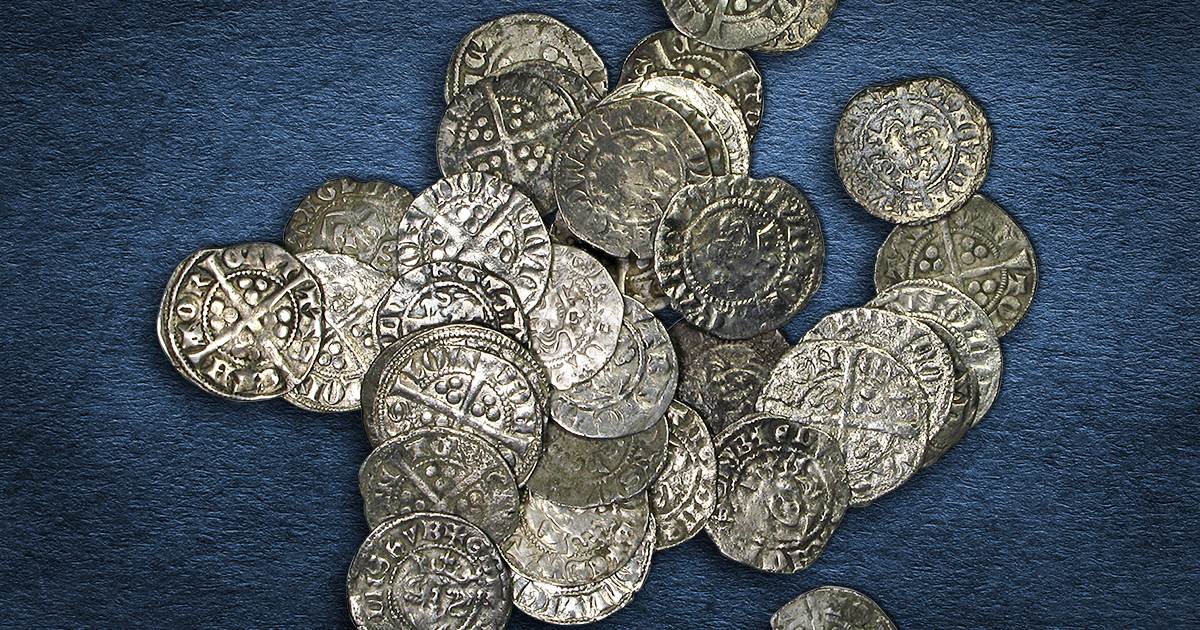
The Tutbury Coin Hoard is one of the largest medieval coin discoveries in British history. The hoard was found in 1831 in the Dove River near Tutbury, Staffordshire. The find contained about 360,000 silver and gold coins and provided a fascinating glimpse into England’s turbulent 14th century. The story of its discovery, contents, and historical significance continues to captivate historians and treasure seekers alike.
Discovery of the Tutbury Hoard
On June 1, 1831, laborers were working to separate the outflow from the primary river flow for a local cotton mill in Tutbury when they noticed silver coins in the gravel of the River Dove. As the workers continued to dig throughout the week, the sheer volume of coins grew, and as they advanced upstream, they found even more coins. The following week, two workers found about 5,000 coins underneath the bridge.
Word About the Hoard Spread
A local paper reported the workers were finding enough coins to earn £10 per day, close to $800 in USD, adjusted for inflation. Within days, word spread in the village of Tutbury and beyond. Hundreds of excited residents flocked to the river with shovels and panning tools, wading waist-deep into the water in hopes of finding a fortune.
How Many Coins were in the Hoard?
It is estimated as many as 100,000 coins were recovered by individuals, though the total hoard was believed to have originally numbered 360,000 pieces. Chaos around the site led to disturbances such as excessive drinking and fights among the diggers. The Crown quickly intervened and issued a Royal Order declaring the coins as royal property. The Staffordshire Yeomanry was called in to enforce the prohibition against further searches, and digging in the area was officially banned.
Contents of the Tutbury Hoard
The Tutbury Coin Hoard mostly held silver coins like early English pennies, but it included some gold pieces as well. These Medieval coins spanned numerous regions and reigns, reflecting the interconnected economies of medieval Britain and Europe and representing the reign of multiple monarchs.
English Monarchs Represented
- Henry III (1216–1272)
- Edward I (1272–1307)
- Edward II (1307–1327)
Scottish Monarchs Represented
- Alexander III of Scotland (1249–1286)
- Robert the Bruce (1306–1329)
- John Balliol (1292-1296)
In addition to these, coins from the Kings of Bohemia and Poland were discovered. Most coins were of comparable size, although one larger coin from Edward II, roughly the size of a silver half crown, stood out as unique.
Theories Behind the Hoard’s Origin
The origin of the Tutbury Hoard is steeped in mystery, medieval intrigue, and political strife. The most compelling theory ties the hoard to Thomas, Earl of Lancaster, who was a prominent baron and cousin to King Edward II. Lancaster’s wealth and military ambitions made him a key figure in the rebellion against the king.
In 1322, Lancaster and his forces clashed with Edward II’s army in the Battle of Burton Bridge. Lancaster’s forces were routed, and he retreated to the Tutbury Castle. During the retreat, Lancaster’s men tried trudging through the flooded Rover Dove with their treasure. According to some accounts, the casks containing the treasure were lost in the water amid the chaos.
Alternative Theories
Hidden by Monks
Some speculate that monks from a nearby priory hid the treasure to protect it from looters or to secure it for the king.
Looters’ Stash
Another theory suggests that looters from Tutbury Castle buried the coins in the riverbank, intending to retrieve them later.
Lost by Lancaster’s Treasurer
Eyewitness accounts suggest that Lancaster’s treasurer may have dropped the casks while attempting to cross the river. Regardless of the specific origin, the hoard remained hidden for over five centuries until 1831.
Aftermath of the Discovery
The discovery sparked immediate interest and controversy. Knowing that hundreds of coins had already been collected by the finders, the Crown demanded their return, citing the treasure trove law. Despite this, only about 1,500 coins were surrendered to the Duchy of Lancaster, who had jurisdiction over Tutbury Castle and its surrounding lands.
It is thought that most of the hoard remained in private hands or was sold off. Efforts to regulate the excavation included a Royal Order by King William IV, one which remains in effect today, prohibiting unauthorized digging in the area. To further deter treasure hunters, the riverbed was eventually covered with gravel.
The Tutbury Hoard’s Legacy
The Tutbury Hoard remains a treasure of immense historical and numismatic significance. It yields insights into the interconnectedness of medieval economies, the reigns of multiple monarchs, and the political upheavals of 14th-century England. Many coins from the hoard are now housed in prestigious institutions, including:
- The British Museum
- Potteries Museum & Art Gallery in Hanley
- Stoke-on-Trent City Museum
The story of the Tutbury Hoard continues to intrigue historians, collectors, and treasure seekers. Its discovery highlighted the enduring allure of buried treasure and the lengths to which people will go to uncover it. Like other English coin hoards, such as the Beau Street Hoard, the true origins of the Tutbury coin hoard may remain a mystery.




